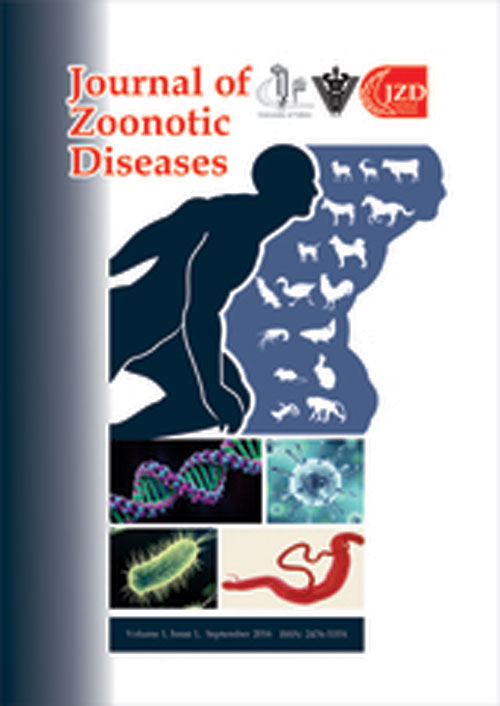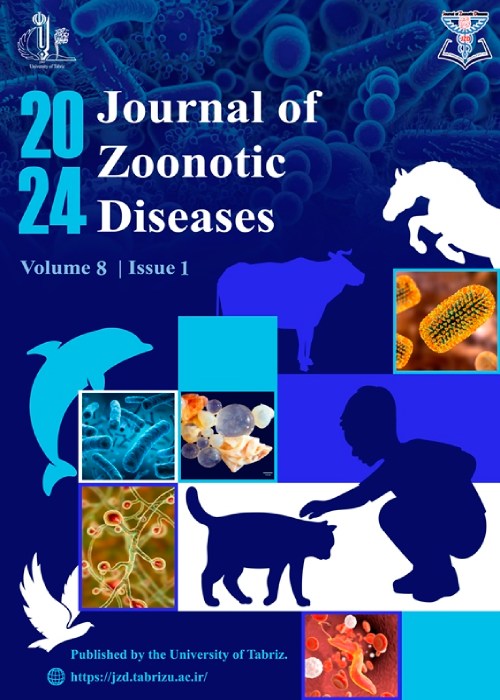فهرست مطالب

Journal of Zoonotic Diseases
Volume:3 Issue: 1, Autumn 2018
- تاریخ انتشار: 1397/09/13
- تعداد عناوین: 6
-
-
Pages 1-9Neospora caninum is an obligate intracellular protozoan parasite of the phyllum Apicomplexa which is considered as one of the major factors in abortion in dairy cows. Serologic evidence suggests that humans are exposed to the organism. The aim of the present survey was to evaluate serological prevalence of Neospora caninum in wild rats in Ahvaz district. Blood samples were collected from 150 adult wild rats. Antibody against Neospora caninum was detected in serum using Neospora agglutination test. Among 150 samples, nine cases (6%) showed infection in 1:20 to 1:320 dilutions. The highest titer of antibody was detected in 1:20 dilution (6%) and the lowest titer was in 1:320 (0.6%) dilution. The antibody titers were as follows: 1:20 (n=9), 1:40 (n=8), 1:80 (n=6), 1:160 (n=2) and 1:320 (n=1). Posititve samples of 6.67%, 3.33% and 10% for N. caninum were identified in north and west, east and center, and south of Ahvaz, respectively. This difference was not statistically (P<0.05) significant and odds ratio was similar in all districts. The seroprevalence was 6.02% in male and 5.97% in female rats which was not statistically (P<0.05). The present study showed that relatively moderate percentage (6%) of rats was infected by Neospora caninum in Ahvaz district. Wild rats can play an important role in the transmission of this parasite to other animals.Keywords: Neospora caninum, Neospora agglutination test (NAT), Seroprevalence, Rat, Ahvaz, Iran
-
Pages 10-21Brucellosis is the most prevalent zoonotic disease in the world, particularly in developing countries. Despite the high prevalence rate of brucellosis in Iran, little information is available regarding the transmission route of the disease. The objective of the present survey was to identify the major risk factors for brucellosis in Northwest of Iran and consequently, to make preventive and therapeutic recommendations for the population. A retrospective study was conducted and all participants were tested by standard tube agglutination test and culture method in districts of Mianeh, Kandovan, Kaghaz kanan and Torkamanchay. The data was obtained from 442 patients using a questionnaire.The majority (48.41%) of the patients aged 10-29 years old of which 63.80% were male. The highest number of cases was reported in 2012 (124 patients, 28.5%). The number of reported cases were significantly declined from 2012 to2016 (P=0.02, r=-0.92). Consumption of raw milk and raw milk-derived cheese (61.76%) as well as having a family member infected with brucellosis (61.53%) were the main risk factors for the disease. In the present study, the most important risk factors were occupation, food consumption and having easy access to unpasteurized milk. These findings indicated that there is still insufficient knowledge about the disease, particularly in urban areas of the country.Keywords: Human brucellosis, Risk Factors, Mianeh, Iran
-
Pages 22-32Chlamydophila psittaci (C. psittaci) remains a significant threat to the health of farming communities in close contact with psittacine birds yet its infection burden remains poorly understood owing to the low accuracy of available diagnostic tests. This study aimed to evaluate the accuracy of chicken embryo (CEI) and mice inoculation (MI) tests and a PCR assay for the detection of C. psittaci in humans. Sputum specimens from 70 Egyptian individuals in contact with psittacine birds were screened for the presence of the pathogen using the three tests. A Bayesian latent class model was used to estimate the Se and Sp of the three tests. The PCR assay had a higher Se (85%; PCI 42.4% - 99.4%) than CEI (68.5%; PCI 24.6% - 95.6%) and MI (47.0%; PCI 12.3% - 85.1%) tests together with a higher Sp (98.9%; PCI 94.1% - 100%) than CEI (98.6%; PCI 93.8% - 99.9%) and MI (98.6%; PCI 93.8% - 99.9%) tests. To our knowledge, this is the first attempt at evaluating the accuracy of these tests for the detection of C. psittaci in humans. The PCR assay clearly outperforms the inoculation tests and hence holds better promise for routine use in surveillance programs for psittacosis.Keywords: Chlamydophila psittaci, PCR, Chicken embryo inoculation test, Mice inoculation test, Bayesian analysis
-
Pages 33-41Rabies remains an important but neglected disease in Africa and Asia. Disparities in the affordability and accessibility of post-exposure treatment and the risks of exposure to rabid dogs result in a skewed distribution of the disease burden across society; with the major impact falling on the rural poor particularly children. Dog bites are the main source of human and animal rabies in Africa, Asia, and South America, and are economically significant. A dog bite victim pays for the mandatory PEP plus incidental costs including transport, food and accommodation making it very expensive. The study established the two-year hospital-based prevalence for dog bites and estimated the economic costs incurred to access PEP at Grade A. Secondary data were obtained from the dog bite victims’ records captured during PEP treatment. The records included the patient’s address, the region of origin or residence, age, sex, incriminated animal species; and whether domestic or stray. A total of 3600 people reported animal bites in the two years; 90.5%, 7.8%, and 1.7% were bitten by dogs, cats and wild animals respectively. Majority of dog bite victims were males below 18 years. A dog bite victim spends USD 91.177 - 288.234 to receive complete PEP treatment. Young males were at the highest risk of being bitten by dogs. High costs were incurred by the victims’ households. Mass dog vaccination must be intensified throughout the country to prevent human exposure to rabies. Public awareness and education should be prioritized.Keywords: Cost, dog bites, PEP, prevalence, rabies
-
Pages 42-47Dirofilariasis is a zoonotic infection caused by Dirofilaria immitis (D. immitis) the causative agent of canine and feline cardiopulmonary dirofilariasis (heartworm disease) in temperate and tropical areas throughout the world and Iran. The parasite is transmitted by different species of culicid mosquitoes. In order to study on D. immitis in healthy urban dogs in Urmia region, and comparison of two diagnostic methods i.e. modified knot test and rapid antigen test kit, the number of 100 dogs (63 males and 37 females) were undertaken to this study in a period of April till July (2014). After physical restriction, blood samples were collected from cephalic or saphenous vein in the appropriate tubes which transferred to the laboratory in an ice pack. Modified knot test was used to recognize D. immitis. Then, all samples were tested by Antigen rapid test kit. There was a difference between the result of modified knot test and rapid test kit. The results indicated that out of 100 samples, 3 samples were infected by D. immitis. There were no significant differences in dirofilariasis infection among different gender and ages. It is concluded the antigen rapid test should be accompanied by another diagnostic method in order to avoid false negative results.Keywords: Dirofilaria immitis, dogs, modified knot test, rapid antigen test, Urmia
-
Pages 48-54Regarding the importance of zoonotic species of Cryptosporidium in humans and domestic animals, and the lack of information about the distribution of Cryptosporidium spp. especially the zoonotic species of aquarium ornamental fish with due attention to their relation to urban water sources and human owners, the present study was designed. Cryptosporidium has been described in more than 17 species of both fresh and saltwater fish with parasites located deep within and on the surface of the stomach or intestinal epithelium. To date, two important species of Cryptosporidium for public health, namely C. parvum and C. hominis have been identified in fish samples from cultured and wild freshwater and marine environments. In this study, identification of Cryptosporidium spp. and zoonotic Cryptosporidium parvum by histopathology and PCR amplification at the 18S rRNA locus among 100 freshwater ornamental fish were performed. Results showed that a total of 16 fish samples (16%) were identified as positive for Cryptosporidium spp. by histopathology. C. parvum was also found in two fish hosts (goldfish). The detection of zoonotic C. parvum in ornamental fish is significant and suggests that the fish might be a good contamination indicator of water with sewage and agricultural run-off.Keywords: Cryptosporidium parvum, ornamental fish, 18S rRNA, PCR


